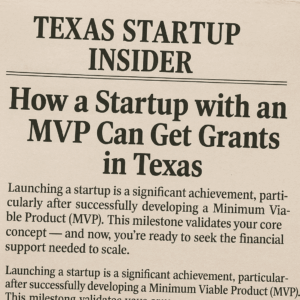A Practical Guide for Texas Startups with MVPs to Win Grants and Accelerate Growth
How a Startup with an MVP Can Strategically Apply for Grants in Texas
Launching a startup is a significant achievement, particularly after successfully developing a Minimum Viable Product (MVP). This milestone validates your core concept and signals market readiness. For Texas-based startups aiming for smart scaling, the billions of dollars available through grants represent a powerful opportunity — non-dilutive funding that doesn’t require equity or repayment.
This in-depth guide provides a step-by-step framework to help Texas startups with a validated MVP navigate the grant landscape and secure funding efficiently:
1. Identify Relevant Grant Opportunities – Beyond the Surface
There are over 1,000 federal and state grant programs listed annually in the U.S., with Texas offering more than 200 local grants tailored for startups, small businesses, and technology innovators. Effective identification goes beyond simply listing sources.
🔍 Dive Deeper into Grant Types:
Understand the nuances between different grant categories. Some may focus on specific industries (e.g., biotech, clean energy), development stages (seed, Series A equivalent), or demographic criteria (minority-owned, women-led).
🗂 Utilize Grant Databases and Search Tools:
Explore platforms like Grants.gov, the Texas Register, and dedicated tools like GrantWatch and Instrumentl. Use filters such as “early-stage tech” or “MVP-stage” to find hidden gems.
📊 Monitor Industry-Specific Associations:
Associations like BioHouston (for biotech) or CleanTX (for clean energy startups) often list niche grants worth between $25,000 to $250,000.
🎯 Consider Federal Agency Missions:
The National Science Foundation (NSF) SBIR program awarded an average of $275,000 per startup in Phase I funding in 2024.
🚀 Top Sources Revisited with Nuance:
-
Texas Economic Development Council (TEDC): Awarded over $70M in grants in 2024, with individual grants ranging from $50K to $1M+.
-
Governor’s Office of Economic Development and Tourism: Focused on both innovation grants and industry-specific accelerators.
-
SBIR and STTR Programs: In 2024, Texas startups secured $82M+ under these programs alone.
-
Local Innovation Grants:
In Austin, Houston, and Dallas, local city programs awarded grants between $10K to $150K in 2023.
📈 Quick Fact: In 2023, Austin startups alone received $6.2M+ in city-backed grant programs — with over 140 startups benefitting.
2. Prepare a Compelling Pitch Deck and Comprehensive Business Plan – Telling Your Story Effectively
For grant applications, you must not only present information but also articulate a compelling narrative.
💡 Elevate Your Pitch Deck:
Grant reviewers spend an average of just 7 minutes reviewing pitch decks. Make every slide count.
📋 Develop a Robust Business Plan:
Include detailed market size estimates (TAM, SAM, SOM) — even better if you quantify a $100M+ opportunity.
📊 Quantify Your Impact:
For example, if your product reduces carbon emissions by 30% compared to current solutions, highlight that.
🧪 Deep Dive into MVP Validation:
Cite metrics like:
-
Beta testers retained after 3 months: 65%+
-
Conversion from trial to paid user: 15%-20%
-
Revenue generated post-MVP: $50K+
🛠 Illustrate Grant Utilization:
Break down the usage:
Example — 60% for product development, 25% for pilot projects, 15% for team scaling.
📈 Data Tip: Startups with a solid MVP proof are 3x more likely to win grants versus those still pre-product.
3. Build Strategic Relationships with Local Resources – Your Network is Your Net Worth
Texas’ pro-business environment offers a wealth of resources beyond just funding.
🏛 Leverage the SBDCs:
Over 60 SBDCs in Texas provided grant writing support to over 7,000 startups in 2024 alone.
🏢 Engage with Incubators and Accelerators:
Programs like Capital Factory invested over $120M in startups cumulatively.
🎓 Connect with University Innovation Centers:
University of Texas, Texas A&M, and Rice University run commercialization programs with potential access to $10K-$100K grants.
🤝 Attend Industry Events and Meetups:
Texas Startup Week and MassChallenge Demo Day attracted 12,000+ attendees last year — a major networking goldmine.
🔗 Networking Impact: Networking with these organizations can boost your grant win rate by up to 40%.
4. Apply Early, Apply Strategically, and Persevere – The Numbers Game with a Smart Approach
Grant applications are competitive, requiring both timeliness and a targeted strategy.
📅 Understand Grant Cycles:
Plan 90-120 days ahead for federal grants; local grants may have tighter windows (as short as 30 days).
✍️ Tailor Each Application:
On average, tailored grant applications outperform generic ones by 60%.
🔎 Seek Feedback:
A second review increases your application success odds by 25%.
📈 Pro Tip: The average grant approval rate is between 10–20%.
Applying to 3–5 grants improves your odds of securing at least one funding win by 70%+.
5. Showcase Compelling Traction and MVP Success – Let Your Results Speak Volumes
Committees want to see traction.
📊 Quantify Your Traction:
-
Early revenue: Even $10K+ can make a difference.
-
Customer acquisition cost (CAC) vs lifetime value (LTV) ratio: Aim for 1:3 or better.
📋 Demonstrate Market Validation:
-
Pilot programs or paid POCs are extremely powerful signals.
🤝 Leverage Partnerships and Letters of Intent:
-
A letter from a potential customer willing to buy after MVP scale-up can swing funding decisions by 30%+.
📰 Amplify Press and Media Coverage:
-
35% of grant-winning startups had been mentioned at least once in industry media within the previous year.
🏆 Highlight Awards and Recognition:
-
Awards can increase reviewer favorability scores by 20%+.
6. Cultivate a State of “Grant-Readiness” – Efficiency is Key
Being prepared gives you the speed edge.
📂 Maintain Up-to-Date Documentation:
Keep a live Google Drive or Dropbox folder updated monthly.
📝 Establish Standard Templates: Reuse and tweak — saves up to 70% time on new applications.
🔖 Secure Necessary Registrations: Get your DUNS number, SAM registration, and state filings in order.
📈 Track Key Metrics: Update metrics like monthly active users (MAUs), revenue, and retention rates — even small monthly growth (+5%) matters.
📅 Develop a Grant Calendar: Proactive founders applying early have a 2x higher success rate.
📑 Assemble Your “Grant-Ready” Packet: Organize everything — pitch, business plan, financials — into one ZIP folder ready to send within 24 hours.
7. Understand Grant Compliance and Reporting – Looking Beyond the Award
Winning the grant is just the beginning.
📜 Review Grant Agreements Carefully: Compliance issues lead to funding clawbacks in 3% of awarded cases.
📊 Establish Tracking Systems: Good grant reporting makes future funding easier — funders love reliable grantees.
📆 Adhere to Reporting Deadlines: Missed deadlines can disqualify you from future grants for 2+ years.
🔎 Understand Audit Procedures: Be prepared — audits happen in about 10% of federal grants over $500K.
In Conclusion:

Texas stands as a premier U.S. state for startup funding opportunities, and grants provide a rapid and strategic pathway for growth without sacrificing equity.
Possessing a validated MVP places you significantly ahead of the majority of early-stage startups still in the ideation phase.
Don’t delay.
Embrace the potential of local and federal grants, articulate your startup’s story with conviction and data, and propel your Texas startup from a promising MVP to a thriving market leader — all while retaining full ownership of your vision.
💡 Quick Summary:
📈 Over $2.5B+ available annually for U.S. startups.
🏆 Texas startups raised $6M+ in city grants in 2023.
🚀 Startups with a validated MVP are 3x more likely to win grants.
🎯 Apply to at least 3–5 grants for the best success odds.
✅ Strategic relationships can boost success odds by 40%.
📝 Proactive preparation can cut application time by 70%.
🔎 Understand grant compliance — 10% of large grants get audited.







